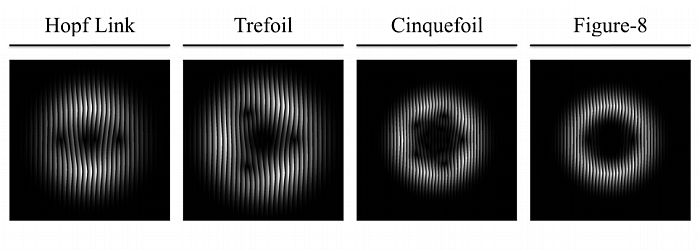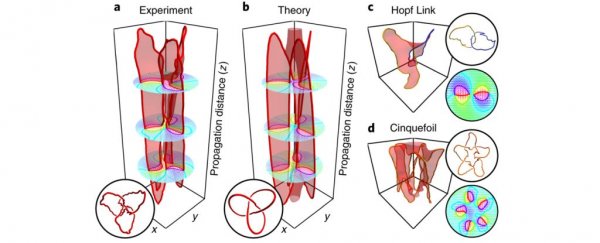Using a new holographic technology, researchers have been able to twist and manipulate a beam of laser light to tie it into knots, creating complex, three-dimensional light structures. Why? To study what happens to the space around them, of course.
It involves manipulating something called polarisation.
To our eyes, a laser beam looks like it's travelling in a straight line. But particles of light - photons - vibrate, very minutely, as they travel. In the case of this particular experiment, the laser light vibrates in an elliptical motion.
The polarisation refers to the direction of this vibration, and polarised materials, such as sunglasses, block photons oscillating in a particular direction.
For sunglasses, that's horizontal, which means they block light reflected off flat surfaces (light directly from the Sun is unpolarised, so that light isn't blocked). But if you take them off and rotate them 90 degrees, they'll block other angles.
So polarised light is light that oscillated along a certain angle. And, by using holograms that shape the beam of light, controlling its intensity and phase profile, the team has twisted that beam into a variety of knots.
"We are all familiar with tying knots in tangible substances such as shoelaces or ribbon. A branch of mathematics called 'knot theory' can be used to analyse such knots by counting their loops and crossings," explained physicist Mark Dennis of the University of Bristol's School of Physics and University of Birmingham's School of Physics and Astronomy.
"With light, however, things get a little more complex. It isn't just a single thread-like beam being knotted, but the whole of the space or 'field' in which it moves. From a maths point of view, it isn't the knot that's interesting, it's the space around it. The geometric and spatial properties of the field are known as its topology."
The spaces between the knotted structure create what is known as a Seifert surface, and creating knotted structures in light creates a new way to study these.
To create their knotted structures, the research team used the holograms to create what are called polarisation singularities, which were first described by physicist John Nye in 1983. This is where the oscillation of the photon becomes circular, with other polarisations wrapping around it.
When they occur in a three-dimensional space, these singularities occur along lines, which the team used to create various kinds of knots - much more complex knots than had previously been created with light.
 (Larocque et al./Nature Physics)
(Larocque et al./Nature Physics)
They created Hopf links, trefoil knots, cinquefoil knots and figure-8 knots - all of which have a level of complexity that exceeds that of any conventional reconstruction of polarisation singularity lines, the researchers said.
They were also able to analyse the Seifert surfaces in fine detail, using a method they called seifertometry, which is used to study the surface structure of the polarisation ellipse orientations around the knotted polarisation singularities.
They found that the real-world surfaces have a lot more holes than were predicted by the mathematics. But they also opened up a new way of studying these surfaces.
"Our method could lead to the development of schemes used to generate and characterise more complicated optical structures that are of fundamental or applied interest," they wrote in their paper.
"Although our intricate apparatus allows for the generation of highly customisable structures, it could also potentially be scaled down using devices that are routinely used to produce polarisation singularities. Such devices could be used to generate simpler structures with reduced aberrations that could be practical for applications."
You can read the full paper in the journal Nature.
